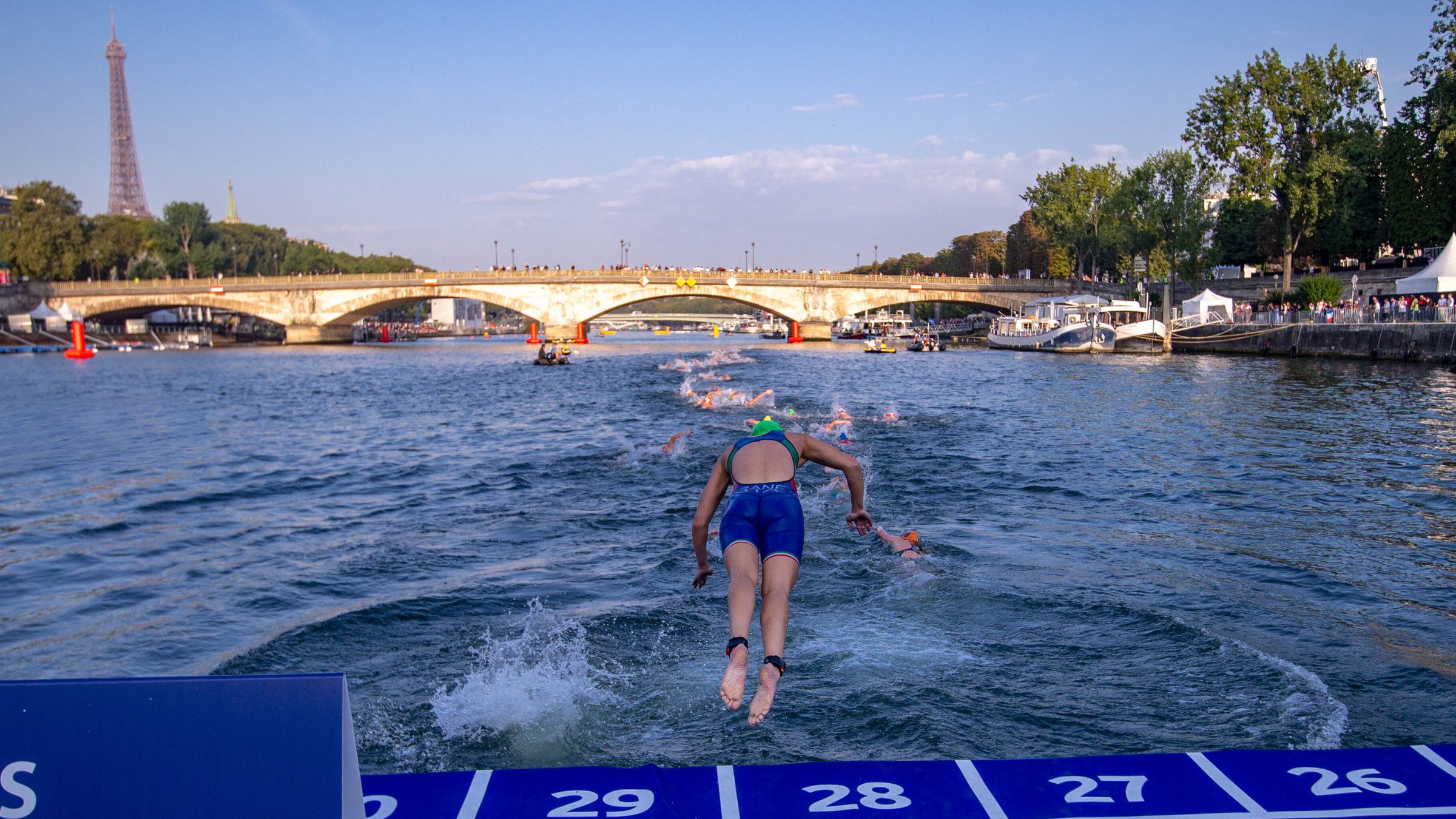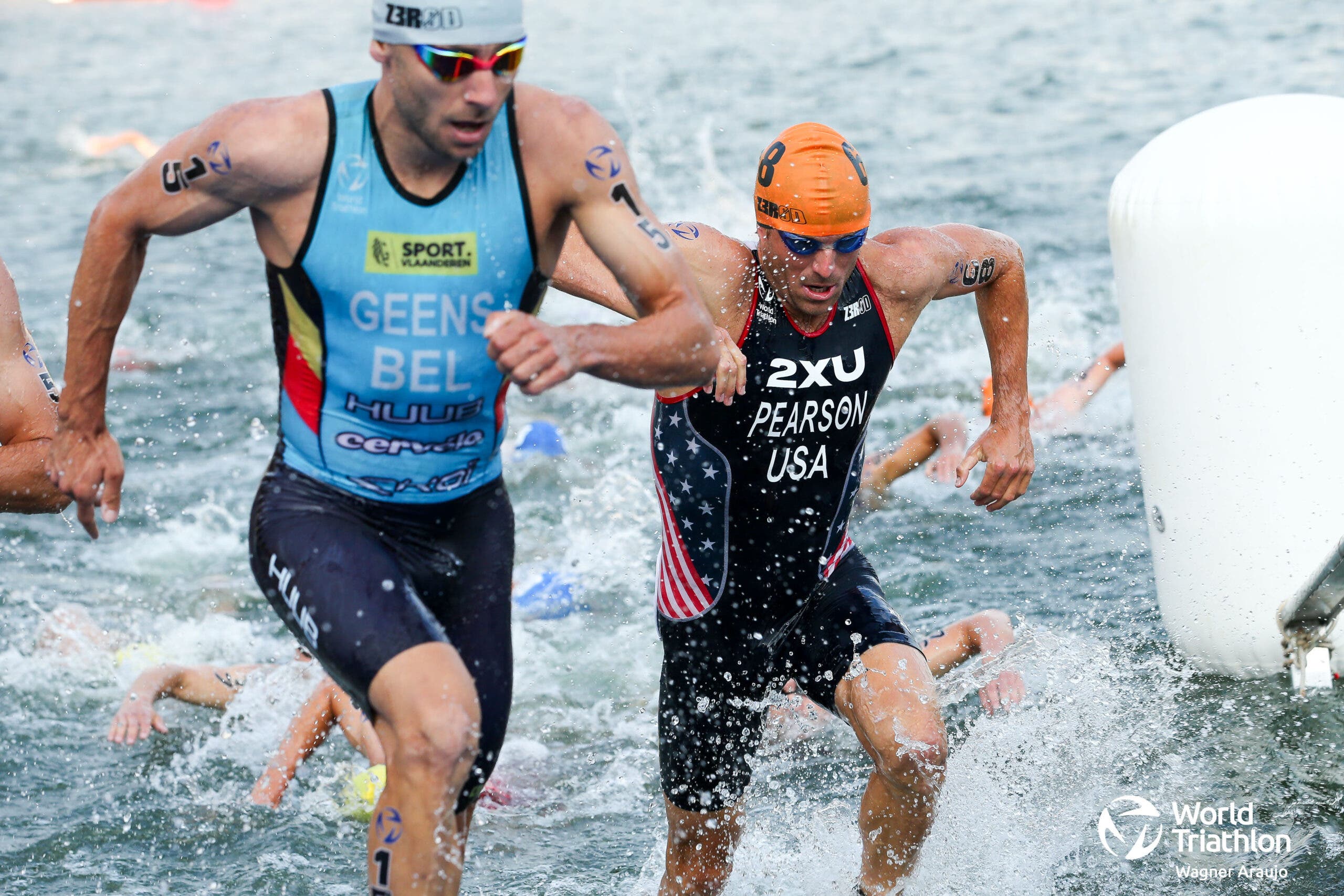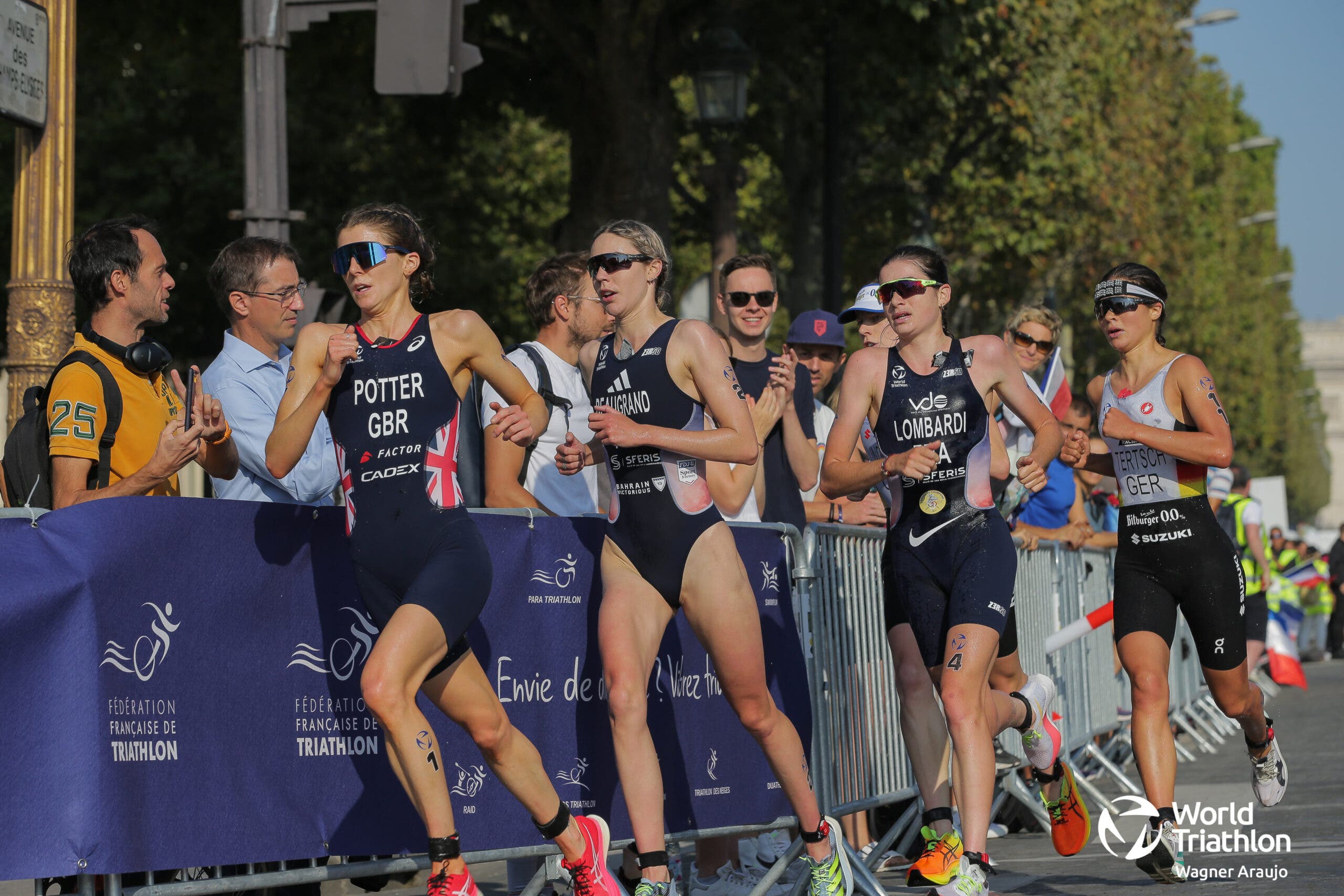Tri Swim Cancellation Rumors Plague Paris Olympics: Athletes, Coaches Respond

One of the biggest questions of the 2024 Paris Olympics: Will the Seine be clean enough to swim in for the triathlon? (Photo: Tommy Zaferes/World Triathlon)
It’s a situation nobody wants, a contingency so unthinkable that the organizers declined to make public the plans they have in place: Canceling the swim of the Paris Olympic triathlon.
You can understand the reticence. While talk of dirty river water has dominated the pre-Olympic headlines, the manifestation of a duathlon or three for a sport that hopes to attract perhaps the biggest crowd of the Games would be the most fecal of matters.
The Paris triathlon competitions are scheduled for July 30 (men’s individual race), July 31, (women’s race) and August 5 (mixed team relay), and despite nagging concerns the local organizing committee and World Triathlon, the sport’s governing body, remain steadfast in their insistence that swimming will be the prelude to biking and running around the cobbles of the capital.
Whisper it: But what if the water quality is too poor? What happens if the readings for bacteria concentration, chiefly escherichia coli and intestinal enterococci, at the four testing sites on the Seine remain stubbornly high? After all, nature is a tricky beast to tame.

Delay over Du?
The water in the Seine River, site of the Olympic triathlon competition, is being tracked on a daily basis. The released data is encouraging (would it be released if it wasn’t?), but the all-important tests to determine whether or not the swim will happen will be carried out at 3:30 a.m. on race morning (4 a.m. on the swim familiarity days of Sunday and Monday, July 28-29) where the enterococci must not be more than 200 parts per 100ml, and E. coli not more than 500 parts per 100ml. You can see the full water quality decision-making matrix in this article.
The information is then relayed immediatly to athletes, coaches, officials and the media, but rather than du, the first step is Plan B: delay.
“If there is any doubt, there will just be no swimming,” Eric Noel, the technical operations manager for triathlon, told La Presse. Noel has experience, having been in charge of Montreal’s World Triathlon Championship Series event in 2022 when the swim was aborted on the Saturday. “World Triathlon standards are extremely strict. In fact, they are harder to meet than the standard swimming standards.”
If either the men’s or women’s race cannot take place due to a failed test, then they will be shifted to Friday, August 2. If both races are postponed, both will take place on August 2; if that plays out, it would mean the men starting at 8 a.m. and the women following quickly because the Seine needs to be open for river traffic by midday. Both medal ceremonies would take place after all the action has finished.
The contingency day for the mixed team relay is August 6, which is only one day later than scheduled, and gives just 24 hours for bacteria levels to drop. While a bigger gap is preferable, there’s little wiggle room in a tightly-packed Olympic roster where any changes have a knock-on effect to logistics and global broadcast schedules.
For example, the marathon swimming events are slated to take place August 8 and 9 in the Seine, but their contingencies include a change of location to the rowing venue at Vaires-sur-Marne.
If the water is still out of commission on August 2 and August 6, then it will be the dreaded duathlon. Despite persistent rumors and suggestions – even including a switch to the French Riviera in Nice – organizers have strenuously denied that moving locations has ever been an option.
Olympic triathlon coaches on the duathlon option
In a duathlon format, the individual races would see a 5km run replace the 1.5km swim, and a 300m swim substituted for a 1km run for each leg of the two-man, two-woman relay as played out in the Paris Test Event last year – although it’s worth noting that much of the $1.5 billion river clean-up scheme was not yet in operation last summer.
“We don’t have a duathlon plan for the Olympics,” says the brutally honest coach Paulo Sousa, whose international triathlon squad has qualified nine of its athletes for Paris, including USA stars Taylor Spivey and Seth Rider. “If the swim is canceled, it will be pretty deflating for everyone involved and the results will be forever asterisked. It will be a historical failure for Paris 2024 that a triathlon couldn’t be held at the Olympics.”
If the swim is canceled, it will be pretty deflating for everyone involved and the results will be forever asterisked. It will be a historical failure for Paris 2024 that a triathlon couldn’t be held at the Olympics.
While there are still medals, prestige and program funding on the line, Sousa’s position is not uncommon among coaches and athletes Triathlete interviewed, who all insisted they were only concentrating their efforts on swim, bike, run.
“To be honest, no,” says Dan Lorang, coach of U.S. representative Taylor Knibb when asked if duathlon prep was part of the Paris training regime. “We just consider a triathlon race, and in [the] case that there will be a duathlon we will adapt quickly to it, but we didn’t do specific training for it.”
In fairness, Knibb is a special case because she also has the cycling time-trial to target on July 27, and the focus of yet another specialism would probably be a stretch. Erin Carson, the 26-year-old’s strength and conditioning coach, is looking at the wider picture.
“I believe that everyone racing, and their teams, are prepared for whatever the Olympic Universe brings on the day,” Carson says. “Our team is confident in both scenarios. Preparations for this year have focused around celebrating the health and happiness of Taylor.”
Jack Maitland, coach of British world champion (and Paris triathlon medal favorite) Beth Potter, takes a similar view. “There’s not really any additional training you could do to prepare for it over and above what you’re already doing,” he says. “The demands of the event as far as run and bike and physiological preparation are concerned are still fundamentally the same.”
Maitland said that an update they were provided last week by World Triathlon detailed the contingencies but painted an upbeat picture for the water quality and speed of the current. “Nobody on the performance side is considering [a duathlon] as far as I know,” he continues. “It’s not been talked about by the athletes or federation. Everyone seems certain it will be a triathlon.”
The Scottish coach, who was instrumental in the success of the Brownlee brothers before coaching Potter, felt that the most likely chance of a duathlon is the mixed team relay if several athletes report sick following the individual events. “That might put them in a situation where they can’t countenance putting [athletes] back in the water,” he adds.
What about the potential of nations withdrawing their athletes from the individual race to concentrate on the relay? “Personally, I think it would be a real shame and detrimental to the sport as a whole,” he says. “So much work has gone into getting those 55 places on the pontoon, if we don’t use them all properly, I can see the IOC [International Olympic Committee] saying we can have 50 next time.
“There’s a fair gap between the races [to recover] but once the idea of saving themselves for a relay enters people’s heads, it doesn’t matter how big the gap is.”
Sousa feels the vibe could reflect the subdued atmosphere of last year’s mixed relay duathlon at the test event. “Whenever a triathlon turns into a duathlon, athletes still go out and do their best, but the overall mood is pretty low,” he explains. “We’ve done a great deal of bike and run training, so our level of preparation is similar to all the other athletes that have spent the last three years preparing for a triathlon.”
Sousa says if the swim is indeed canceled in the Paris Olympic triathlon, “We’ll adapt our plans for that eventuality. But right now we need to be fully focused on one place, and that’s racing a triathlon on July 30 and 31.”
How would a duathlon shake up the Olympic triathlon podium?

While a wait-and-see approach by athletes and coaches might seem a short-sighted – after all, they’ll have little more than four hours notice of the change – Sousa points out that in the last major short-course race to be reduced to a run-bike-run, the European Championship in Marid last summer, an Olympic-bound member of his squad, Jeanne Lehair, triumphed. Triathlete‘s Olympian commentators agreed, with both Lisa Norden and Andy Potts predicting a duathlon could significantly change dynamics in both the women’s and men’s individual races.
Training might not alter much, but as both the Luxembourg athlete and her coach can attest, the demands of a duathlon are not the same, and will by definition suit athletes who are comparatively stronger on the run than the swim.
“There’s a huge difference between running 5km as opposed to swimming 1.5km.” Sousa continues. “Basically, it’s all leg work, and for sure you will be feeling those legs at the start of the bike.”
Sousa also believes that a duathlon increases the chances of the race breaking up more, something that the test events suggested would otherwise be difficult on a flat course with wide roads.
“The first run is not entirely tactical,” he adds. “The best runners will try to make a difference and create a small group at the front of the race. This makes for a very high-intensity first run.
“The sport of triathlon [also] self-selects athletes who have a very homogenous level of swimming and the differences are larger on the run. Part of this is due to the effect of drafting in the water.
“When you start a run, those larger run differences have the potential to cause a more fragmented field at T1, and because run differences are larger for the women, I think the potential for a smaller [bike] group is larger for the women.”
Looking at last year’s test event results, there was a 40-second span across the top 30 fastest male swimmers and 46 seconds from the first female swimmer to 30th out of the water. The race-winning Brits were quickest on their respective 10km runs with the 30th fastest man running 2 minutes 17 seconds slower than Alex Yee, and the 30th fastest woman splitting 2 minutes 11 seconds slower than Beth Potter.
While this one example doesn’t back up Sousa’s rationale that the gaps are larger on the women’s run, if does show that even if you halved the gaps (ie. for a 5km run) they are still around 20 seconds larger than following the swim – more than enough for an early breakaway at the front of the race.
Maitland doesn’t see it quite the same way as Sousa though. “I think the critical separation is less [in a duathlon],” he explains. “I wouldn’t expect Cassandre Beaugrand, Lisa Tertsch, Emma Lombardi and Flora Duffy to be distanced in the first 5km. There might be more of a gap further back [in the field], but it’s not going to affect the front end of the race. The people who are likely to be there at the death [in a triathlon] are likely to be the stronger runners anyway, so they are less likely to be separated by the first run.
“It will change the dynamics of the event, and probably bring people into the race who wouldn’t necessarily be there following the swim and vice versa. For example, someone like [France’s] Leonie Periault is going to be a factor, whereas that might be less likely with a triathlon.”
While Maitland doesn’t feel that including run-bike brick sessions into training offers much value – “Running after the bike tends to be more problematic than biking after the run” – he does believe pacing is critical.
“The tendency is to go too hard on the first run. It needs to be considered as a 15km run where you hold the position near the front of the race. Somebody who needs to deliver their best 5km to be in the front pack will be in a difficult situation because that effort comes at a cost.”
What the athletes say
One of the few athletes who looked as if he might be preparing for the prospect of a duathlon was Belgium’s Marten Van Riel. The 31-year-old who finished sixth in Rio in 2016 and fourth in Tokyo three years ago has said this will be his last shot at Olympic glory and posted run-bike transition footage on Instagram on Wednesday with the hashtag #duathlon.
While Van Riel was having some fun with the post, he clarified to Triathlete that it was simply transition practice where he didn’t want to risk running barefoot. “But I guess it’s the same as duathlon!” he added.
There are few silver linings of a canceled swim, but to end on a positive note, one consequence of a duathlon is that is removes the need for mouthwash, anti-nausea medicine, hospital disinfectant, and even a can of Coca-Cola that some triathletes will take as a precautionary measures ahead of taking a dip.
“We will use mouthwash straight away and things like Pepto-Bismol [anti-nausea medication] just to line your stomach before and after the race,” Great Britain’s Tokyo gold and silver medal winner Georgia Taylor-Brown told The Times of London.
The Brit, who returns in Paris hoping to add to her medal count, continued to say that the risk of illness after a triathlon is nothing new in the sport and poor water quality is a sad indictment of the global challenge it faces.